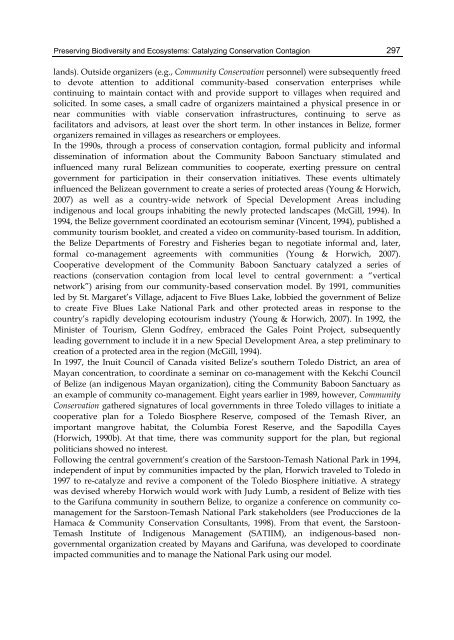DEFORESTATION AROUND THE WORLD - India Environment Portal
DEFORESTATION AROUND THE WORLD - India Environment Portal
DEFORESTATION AROUND THE WORLD - India Environment Portal
Create successful ePaper yourself
Turn your PDF publications into a flip-book with our unique Google optimized e-Paper software.
Preserving Biodiversity and Ecosystems: Catalyzing Conservation Contagion<br />
lands). Outside organizers (e.g., Community Conservation personnel) were subsequently freed<br />
to devote attention to additional community-based conservation enterprises while<br />
continuing to maintain contact with and provide support to villages when required and<br />
solicited. In some cases, a small cadre of organizers maintained a physical presence in or<br />
near communities with viable conservation infrastructures, continuing to serve as<br />
facilitators and advisors, at least over the short term. In other instances in Belize, former<br />
organizers remained in villages as researchers or employees.<br />
In the 1990s, through a process of conservation contagion, formal publicity and informal<br />
dissemination of information about the Community Baboon Sanctuary stimulated and<br />
influenced many rural Belizean communities to cooperate, exerting pressure on central<br />
government for participation in their conservation initiatives. These events ultimately<br />
influenced the Belizean government to create a series of protected areas (Young & Horwich,<br />
2007) as well as a country-wide network of Special Development Areas including<br />
indigenous and local groups inhabiting the newly protected landscapes (McGill, 1994). In<br />
1994, the Belize government coordinated an ecotourism seminar (Vincent, 1994), published a<br />
community tourism booklet, and created a video on community-based tourism. In addition,<br />
the Belize Departments of Forestry and Fisheries began to negotiate informal and, later,<br />
formal co-management agreements with communities (Young & Horwich, 2007).<br />
Cooperative development of the Community Baboon Sanctuary catalyzed a series of<br />
reactions (conservation contagion from local level to central government: a “vertical<br />
network”) arising from our community-based conservation model. By 1991, communities<br />
led by St. Margaret’s Village, adjacent to Five Blues Lake, lobbied the government of Belize<br />
to create Five Blues Lake National Park and other protected areas in response to the<br />
country’s rapidly developing ecotourism industry (Young & Horwich, 2007). In 1992, the<br />
Minister of Tourism, Glenn Godfrey, embraced the Gales Point Project, subsequently<br />
leading government to include it in a new Special Development Area, a step preliminary to<br />
creation of a protected area in the region (McGill, 1994).<br />
In 1997, the Inuit Council of Canada visited Belize’s southern Toledo District, an area of<br />
Mayan concentration, to coordinate a seminar on co-management with the Kekchi Council<br />
of Belize (an indigenous Mayan organization), citing the Community Baboon Sanctuary as<br />
an example of community co-management. Eight years earlier in 1989, however, Community<br />
Conservation gathered signatures of local governments in three Toledo villages to initiate a<br />
cooperative plan for a Toledo Biosphere Reserve, composed of the Temash River, an<br />
important mangrove habitat, the Columbia Forest Reserve, and the Sapodilla Cayes<br />
(Horwich, 1990b). At that time, there was community support for the plan, but regional<br />
politicians showed no interest.<br />
Following the central government’s creation of the Sarstoon-Temash National Park in 1994,<br />
independent of input by communities impacted by the plan, Horwich traveled to Toledo in<br />
1997 to re-catalyze and revive a component of the Toledo Biosphere initiative. A strategy<br />
was devised whereby Horwich would work with Judy Lumb, a resident of Belize with ties<br />
to the Garifuna community in southern Belize, to organize a conference on community comanagement<br />
for the Sarstoon-Temash National Park stakeholders (see Producciones de la<br />
Hamaca & Community Conservation Consultants, 1998). From that event, the Sarstoon-<br />
Temash Institute of Indigenous Management (SATIIM), an indigenous-based nongovernmental<br />
organization created by Mayans and Garifuna, was developed to coordinate<br />
impacted communities and to manage the National Park using our model.<br />
297

















